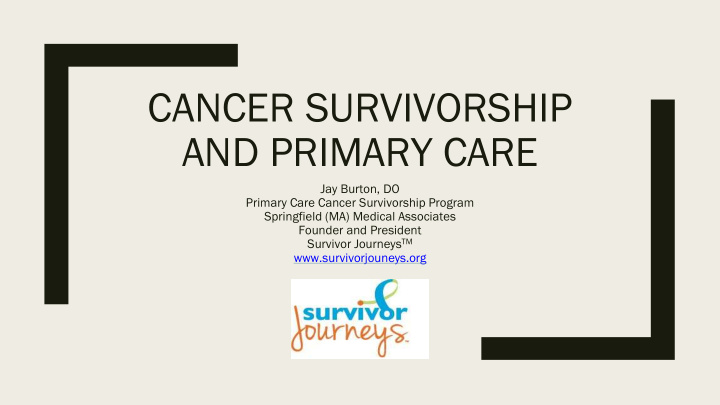



CANCER SURVIVORSHIP AND PRIMARY CARE Jay Burton, DO Primary Care Cancer Survivorship Program Springfield (MA) Medical Associates Founder and President Survivor Journeys TM www.survivorjouneys.org
Definitions ■ Who is a cancer survivor? The moment you are diagnosed with cancer – ■ What is cancer survivorship? Living before, during, and after cancer treatment –
Statistics ■ As of January 2019, there are approximately 16.9 million cancer survivors in the US 5.0% of the population – Projected to increase by 29.1% to 21.7 million by 2029 – Projected to grow to 26.1 million by 2040 – ■ In 2019, 67% of survivors (10.3 million) have survived 5 or more years after diagnosis 45% have survived 10 or more years – 18% have survived 20 or more years – Over the next decade, the number of survivors who have lived 5 or more years after diagnosis is set to – increase by almost 33%, to 15.1 million ■ 64% of survivors are currently 65 years of age or older By 2040, it is estimated that 73% of cancer survivors in the US will be 65 or older – ■ Most common cancer sites Female breast (23%, 3.6 million) – Prostate (21%, 3.3 million) – Colorectal (9%, 1.5 million) – Gynecological (8%, 1.3 million) – Melanoma (8%, 1.2 million) – Office of Cancer Survivorship /National Cancer Institute/NIH
Graph of Cancer Survivors
Challenges for Providing Primary Care Cancer Survivorship Services 1. Create Awareness about Cancer Survivorship 2. Educate Yourself about Cancer Survivorship 3. You Can’t Do This Alone
Essence of Primary Care Cancer Survivorship
Basic Tenets of a Cancer Survivorship Care Program ■ Expressing passion for providing high quality cancer survivorship care ■ Educating yourself and colleagues about cancer survivorship ■ Understanding the medical components of cancer survivorship care (the easy part) ■ Understanding the psychosocial, spiritual, and economic experiences of the cancer survivor (the hard part) ■ Enlisting the cooperation of the practice administrator ■ Educating all staff about basic cancer survivorship Educating cancer survivors, their caregivers and families about primary care cancer survivorship ■ Enlisting cooperation and collaboration from oncology colleagues. ■ Salesmanship ■ ■ Collaborating with other care providers ■ Networking ■ Developing infrastructure ■ Identifying and developing relationships with community mental health professionals ■ Developing cancer-specific support systems within the practice and/or community. ■ Connecting with or develop a mentoring program
Framework for Developing a Cancer Survivorship Program 1. 1. Estab ablish a a work g group of key stak akeholders, including can ancer surviv ivors, prim imary car are staf aff, administrators, oncology gy t team m memb embers a and commu mmunity leader ders a) What do cancer survivors want? b) What do cancer survivors need? c) Who is the target population – all survivors or specific groups d) What is the anticipated volume of survivors for the practice? 2. 2. Condu duct an inter ernal and external needs eeds a asses essme ment a. Identify strengths and weaknesses of current programs b. Identify gaps between current conditions and ideal services for cancer survivors c. What resources are currently available in the practice and in the community? d. What additional services and resources are feasible in this setting?
Framework for Developing a Cancer Survivorship Program 3. Deve velop a op a written plan a. Define the program’s purpose and mission. b. Identify specific services to provide and who can provide them. c. Select a model that best fits the needs of survivors and the available resources d. Develop written program goals and specific outcome measures. e. Develop a plan to coordinate and communicate with oncology practices and other partners essential to the program. f. Identify the educational needs for health care providers, patients and the public g. Determine short, intermediate and long-term outcome measures h. Develop a marketing plan
Framework for Developing a Cancer Survivorship Program 4. 4. Pilo Pilot the plan lan 5. 5. Evalu aluat ate an and revis ise the program a. Which activities and services were effective in meeting survivor needs? b. Which elements of the program are most effective? c. What changes would participants recommend? d. Measure patient satisfaction and knowledge, adherence to clinical recommendation for follow-up and lifestyle changes, and quality of life 6. 6. Expa pand the he pro program Acknowledgement: George Washington University Cancer Center. (2013). Guideline for Developing Quality Survivorship Care. Washington, D.C.: GWU Cancer Institute; ASCO.org. (n.d.) Needs Assessment Questionnaire.; American Cancer Society and the George Washington Cancer Institute. (nd.) Moving Beyond Patient Satisfaction: Tips to Measure Program Impact.
Essential Elements of the Past Medical History of the Primary Care Chart of a Cancer Survivor 1. Cancer Diagnosis 2. Cancer Treatment 3. Complications of Cancer/ Treatment 4. Surveillance
Resources ■ Cancer Survivorship: Transdisciplinary, Patient-Centered Approach, Chapter 3 Developing a Primary Care Cancer Survivorship Program; Oncology Nursing Society (In Publication) ■ www.survivorjourneys.org Resources PCCSP ■ Cancer Survivorship E-Learning Series for Primary Care Providers ■ cancer.net
Recommend
More recommend